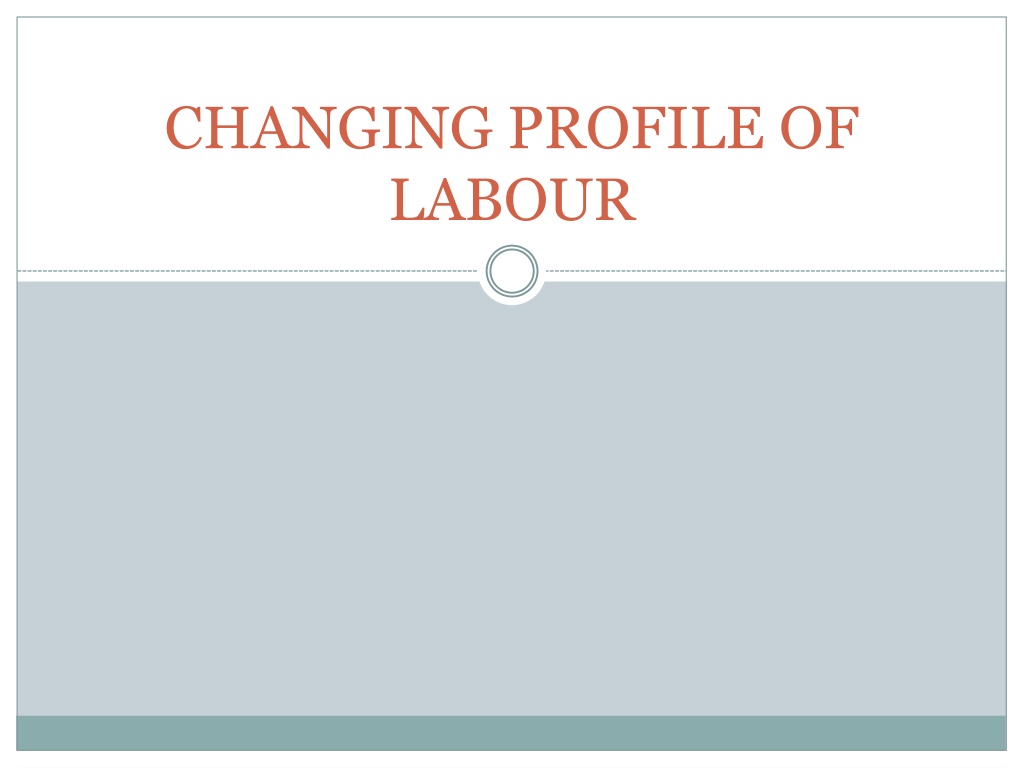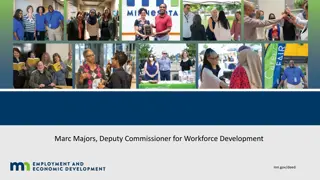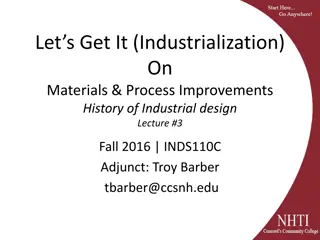Transforming Dynamics of the Indian Industrial Workforce
The Indian industrial worker has transitioned over time from a state of no rights to now having legitimate rights and organized representation through unions. This evolution reflects societal changes, including improved education, economic status, and dignity for labor contributions. Moreover, political shifts have granted workers more rights and protections, enhancing their status as valued contributors to the production process.
Download Presentation

Please find below an Image/Link to download the presentation.
The content on the website is provided AS IS for your information and personal use only. It may not be sold, licensed, or shared on other websites without obtaining consent from the author.If you encounter any issues during the download, it is possible that the publisher has removed the file from their server.
You are allowed to download the files provided on this website for personal or commercial use, subject to the condition that they are used lawfully. All files are the property of their respective owners.
The content on the website is provided AS IS for your information and personal use only. It may not be sold, licensed, or shared on other websites without obtaining consent from the author.
E N D
Presentation Transcript
CHANGING PROFILE OF LABOUR
The Indian industrial worker has changed over a period of time. He has marched from a situation where he had no right (slavery) to a situation where he is able to encroach on the rights of employer, though not fully, at least partly.
The status of Indian industrial worker has undergone substantial change. He is no more a mere element of production. . From the status of an illiterate human being having two hands to contribute the labour in the process of production but having no rights, to the status of an educated worker with legitimate rights, presenting himself in organised form via union has come in existence on Indian industrial scene.
CHANGING SOCIETY Changing society has offered many things. The better level of education and to some extent comparatively better economic status, and above all some dignity to his contribution labour, are some of the dimension added by changing society. Thus, the changes in society have changed the nature and structure of work force. The changed nature of workforce brings changes in value system and also changes in expectations either monetary or nonmonetary or both.
changing political system The changing political system also added certain dimensions to his personality The changing political system offered him certain legitimate rights, and offered a status of dignified free citizen in democratic political system. Not only that, various enactments flowing from the spirit of Indian constitution has come forward to secure job and protect his legitimate rights. The principle of social justice has always come forward to help him. The organised strength in the form of union has not only protected his rights but also continued its efforts in adding various benefits and rights to him
The democratic political system also has added another dimension to changing workforce. Union (LABOUR UNION OR TRADE UNION) with its collective bargaining strength, in certain cases or circumstances, has been able to share or snatch certain rights of the employer. The industrial worker has been able to change his image as helpless, weak and merely an element of production. On the contrary, he has acquired the image as strong, organised, and powerful element contributing in production process. As a result of this he has been able to share legitimate economic fruits.
The emerging new working class is certainly having changed profile expectations along with changed The changed profile, changed expectations, changed attitudes and value system, dimensions showing changes in new worker. are few of the
The other dimensions apart from social, political and economic changes those have brought changes in workforce are scientific inventions and technological innovations. Technological innovations and scientific inventions have brought great deal of changes at work system and have placed demands of higher and newer skills and education on country's workforce.
All these dimensions make more difficult the task of managing the resources both human and material. It also adds to complexity of relations existing among the groups and people in organisations. The management of people in changed circumstances then demands a fresh view and approach to cope with the new environment. It also demands the discovery of or the search for new ways and means to deal with human problems for better productivity and prosperity. As a consequence, new challenges face all those concerned with institutional life either industrial or otherwise, for instance the management of industrial organisations working in the field, academicians, the policy formulators, and students are concerned with such challenges of changed workforce.
CHANGING PROFILE OF INDIAN LABOUR: A.K.Natarajan states that the "profile of the modern young worker has considerably changed. He is hostile and questioning and his needs and aspirations are complex."(in N.K. Sing et al 1977, p.105) He also states that "the young workers are still primarily motivated by economic incentives. Nonmonetary motivational drives including opportunity for self-expression are also necessary to make them do better. The young workers resist the authoritarian behaviour of management and the manner in which changes are introduced. However, the changing nature and structure of workforce is in fact a global phenomenon.
Drucker (1985: P.146) states that the skills and the knowledge of people, their work, their life spans and their health have changed and can change rapidly, even though the human nature has not changed over a recorded history. He states that in no area, not even in technology, have the changes of the last thirty years been greater than in the workforce. EXAMPLE; workforce of 1920 on Henry Ford's assembly line rather than the knowledge worker of today. When they say. worker' they tend to see a male adult, aged twenty to sixty-five, working on the machine and employed full time in a permanent job. Yet more than half of the American labour force today consists of women and of people past sixty-five, a good many of them working part time or intermittently. Thus, this indicates that the labour force is changing and knowledge worker with change in composition, working habits and working life is emerging. The changing nature of workforce is global phenomenon.
Flippo (1980) commenting on changing labour force states that many problems are caused by constant changes that occur both within and without firm. He states that major changes are, (1) increased number of minority members entering occupations requiring greater skills; (2) increasing levels of formal education for entire workforce (3) more female employees (4) more married female employees (5) more working mothers (6) steadily increasing majority of white collar employees in place of blue collar".
National Commission on Labour (1969). It highlights various changes in Indian labour force since independence. It states "that the process of planning initiated in 1950- 51, development and harnessing of the country's resources have gained momentum. Progress recorded so far has added fresh dimension both to the nature and scale of development activities in the country. Electricity generation has increased. The industrial base of the economy could now be considered as fairly well developed, simultaneously, the industrial structure has been greatly diversified and strengthened.
In addition to the traditional large-scale industries viz., cotton and jute, textile, sugar, tea, paper board and cement, a number of new industries, including heavy electrical, heavy chemicals, petrochemicals, fertilizers, machine tools, mechanical engineering established. automobiles industries and been have Facilities of higher education especially technical education have been enlarged. Thus, in the years since independence, the Indian economy has entered on expansionary phase.
A new worker is emerging within the category of "industrial labour"- with a distinct urban characteristics and social mobility. It states "the industrial worker of today has acquired a dignity not known to his predecessor. He is no longer the unskilled coolie, of the days gone by engaged in an unending struggle to eke out his existence, neglected by society except for his labour and with very limited aspirations. He has now a personality of his own. .
The impact of this change is seen not only at the place of work, but also in house where earning members have established equality with seniors in the family and seek reciprocate social calls from colleagues in the place of work. "The sex composition of workers has shown a change. Women workers, often educated, take skilled and semiskilled work in modern factories."
Commenting on aspirations and attitudes of the worker, NCL (1969) states "a worker today is better aware that learning is essential for improved earnings. He is keen about self-education and even keener about education of his children and their future. And this aspiration is not confined to the urban worker; it has travelled to rural areas.
The reasons for changing aspirations as per National Commission on Labour (NCL) are mainly (a) Awareness by worker that learning is essential for better earning, (b) Higher skills and educational requirements expected of workers in modern factories, (c) Change in social composition of labour because of social mobility (d) Increased facilities of higher education especially technical education, (e) Induction of large number of young workers with changed level of education. On the literature of changing Indian worker, national commission on labour (NCL) report stand as a landmark.

 undefined
undefined










































